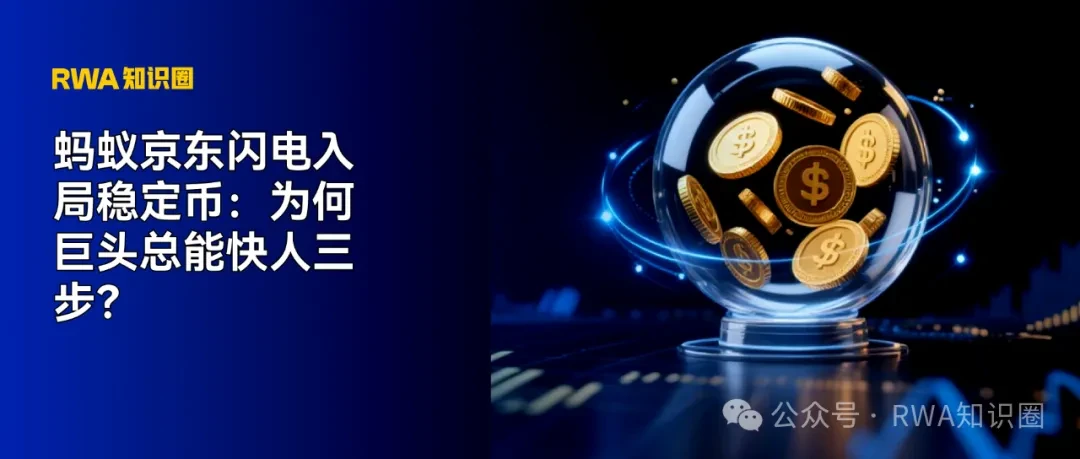
1. From Tether to Ant Group and JD: Why Have Stablecoins Become a Battleground for Giants?
In 2014, Tether issued the world's first stablecoin, USDT, at a time when cryptocurrency was still a niche experiment. Fast forward to June 2025, JD and Ant Group announced their applications for Hong Kong stablecoin licenses, causing a stir in the market. This is not a spur-of-the-moment decision—stablecoins have become the core infrastructure in the field of RWA (Real World Assets) tokenization, especially in cross-border trade, asset liquidity, and enterprise-level payment scenarios, where their value is being redefined by the market.
For B-end enterprises, the three major demands for stablecoins have emerged:
Cost reduction and efficiency improvement in cross-border payments: Traditional SWIFT cross-border settlements take 2-3 days, while blockchain-based stablecoins can achieve near-instantaneous transactions, reducing fees by over 70%;
Upgraded asset liquidity: On-chain funds can be disassembled and recombined in real-time, solving mismatched payment terms;
Compliant digital asset management: Stablecoins pegged to fiat currencies serve as a "compliance passport" for enterprises entering the Web3 world.
2. The Giants' Positioning Battle: Policy Sensitivity Determines Commercial Opportunities
Rome wasn't built in a day. While many B-end enterprises have yet to realize the commercial potential of stablecoins, tech giants like Ant Group have already laid out their strategies in advance based on policy evolution. From the development trajectory of Hong Kong's "Stablecoin Regulatory Framework," Ant's actions resonate with policy timelines:
2023: Hong Kong releases the world's first "Stablecoin Regulatory Framework," and Ant immediately begins technical preparations;
April 2025: Ant Group signs a contract with the Hong Kong government, establishing its overseas headquarters;
May 2025: Collaborates with HSBC to complete real-time allocation of tokenized deposits, validating on-chain settlement capabilities;
June 6, 2025: Hong Kong announces that the "Stablecoin Ordinance" will take effect on August 1, and Ant announces its first batch of license applications on June 12.
This "policy - technology - ecosystem" closed loop demonstrates the logic of stablecoins as a pivot in the giants' global financial service strategies. Taking Ant International as an example, its three major businesses—Alipay+ (cross-border payments), Wanlihui (cross-border finance for SMEs), and Antong (merchant acquiring)—naturally align with stablecoins. In 2024, out of over $1 trillion in funds flowing through Ant International, $300 billion has already been processed via blockchain—if half of this were to migrate to its own stablecoin system, it would activate an endogenous transaction volume of $150 billion, equivalent to creating another cross-border payment giant.
3. Technological Moat: How to Support Trillion-Level Enterprise Applications
Stablecoins are just the tip of the iceberg for RWA. A deep dive into Ant's technical architecture reveals that these investments hold significant implications for enterprises seeking compliant development:
High-performance trading engine: The Layer2 blockchain Jovay, designed specifically for RWA, supports 100,000 TPS and 100 milliseconds response time, making it a thousand times faster than Ethereum;
Developer ecosystem tool: The open-source virtual machine DTVM is Ethereum-compatible and integrates the AI framework SmartCogent, lowering the development threshold for enterprises;
Asset on-chain infrastructure: The "Two Chains and One Bridge" (AntChain asset chain + cross-chain bridge + Jovay) opens up tokenization pathways for trillion-level physical assets like new energy.
The advancement of blockchain technology marks the entry of RWA into the "millisecond-level trusted transaction" era—enterprises can complete complex operations such as bulk energy trading and supply chain finance on-chain, with stablecoins becoming the "lifeblood" of these scenarios.
4. Opportunities for SMEs: Golden Opportunities Still Exist in the RWA Track
As giants like Ant, JD, and Amazon seize the high ground, do SMEs have no chance? Absolutely not! The core value of RWA lies in the diversification of asset types and scenarios.
Fragmentation:
Niche markets such as new energy, supply chain bills, and real estate are still blue oceans;
Customized stablecoin solutions are needed for regional trade and vertical industry settlements.
However, SMEs must overcome three major hurdles:
License compliance: License applications in places like Hong Kong take 6-8 months and involve legal structures and reserve fund audits;
Technical architecture: On-chain issuance, custody, and cross-chain integration development costs exceed one million dollars;
Ecosystem expansion: Challenges in building liquidity pools and integrating merchant access.
Professional institutions are becoming key drivers for breaking through these barriers, providing full-cycle support for SMEs: from designing compliance pathways for licenses from Hong Kong MAS to Singapore MAS, to lightweight development frameworks based on open-source tools like DTVM; from tokenization services connecting to banks and custodians, to precise ecological guidance for cross-border e-commerce scenarios, forming a closed-loop solution covering licenses, technology, funding, and market.
5. Stablecoins as the "Digital Infrastructure Revolution" in B-End Finance
From the heavy deployment by giants to the penetration of SME scenarios, stablecoins are evolving from "cryptocurrency tools" to enterprise-level financial operating systems. With the Hong Kong "Stablecoin Ordinance" taking effect in August, Chinese enterprises will usher in a new round of "licensed competition." For SMEs, achieving a "compliance + technology + ecosystem" trifecta through systematic knowledge empowerment and resource integration presents a genuine opportunity to share in the dividends of cross-border trade and vertical industry chain finance scenarios—after all, the future of the digital economy is not a solo performance by the giants.
免责声明:本文章仅代表作者个人观点,不代表本平台的立场和观点。本文章仅供信息分享,不构成对任何人的任何投资建议。用户与作者之间的任何争议,与本平台无关。如网页中刊载的文章或图片涉及侵权,请提供相关的权利证明和身份证明发送邮件到support@aicoin.com,本平台相关工作人员将会进行核查。




